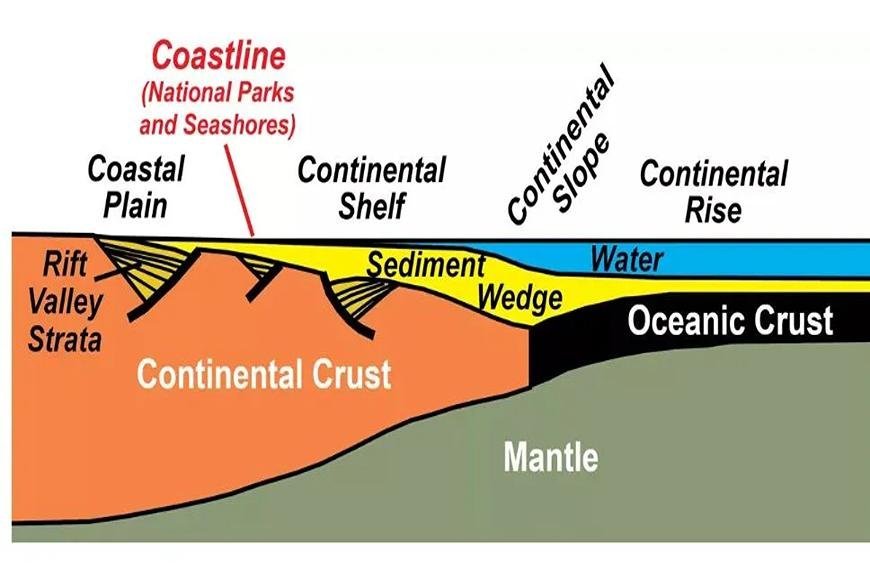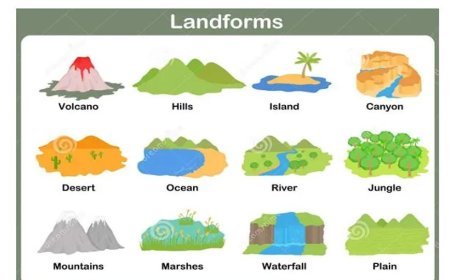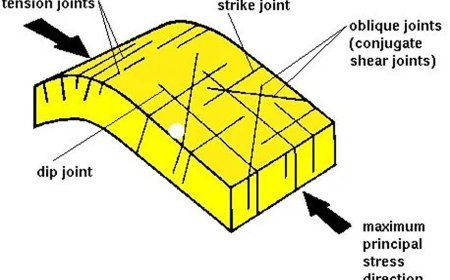CONTINENTAL SHELF
Continent's Underwater Edge: The Continental Shelf - Shallow Seas Where Land Meets Ocean Floor.

Continental Shelf
- A continental shelf is a section of the continent that is buried beneath the shelf sea, a body of relatively shallow water.
- During glacial eras, sea levels significantly dropped, exposing the shelves.
- The insular shelf is a shelf that has an island surrounding it.
- Between the continental shelf and the abyssal plain, the continental margin consists of a steeply shaped continental slope and a continental rise, where silt from the continent above the cascades and down the slope has accumulated in a pile at the slope's foot.
- This consists of thick sediments created by turbidity currents that originate on the shelf and slope and extend up to 500 kilometers (310 miles) from the slope.
Continental Zone
- The continental shelf, also known as the zone, is a wide, shallow underwater terrace formed at the margin of a continent.
- The geological properties of the continental shelves are quite similar to those of the continent's neighboring exposed region.
- The bulk of the shelves have a ridge, which is a gently undulating geographical feature.
- The continental shelves account for approximately 8% of all maritime landforms.
Continental Shelf Structure
- A continental shelf extends from the shore to depths of 100–200 meters (330–660 feet).
- They descend gently to the sea, with an average slope of around 0.1°.
- The shelf stops suddenly at the sea's edge in all of these circumstances, which is known as the shelf break.
- The continental rise lies under the continental slope, which has a steeper zone that joins the oceanic floor.
- The depth ranges between 4,000 and 5,000 meters (or 13,000 and 16,500 feet).
- Few continental margins, such as those along France's Mediterranean coast and off Ireland's Porcupine Bank, have a definite definition of the slope, instead exhibiting a typically convex form towards the seafloor.
- The world's largest continental shelf extends for approximately 1,210 kilometers (750 miles) off the coast of Siberia, Russia, and into the Arctic Ocean.
- The continental shelves extend from the coastal plains.
- They are distinguished by broad, sloping submerged plains that cover about 7.4% of the world's ocean surface above continental shelves and have an average width of about 78 km (48 miles) worldwide.
- The continental shelf is 65 kilometers (40 miles) wide on average.
- The vast bulk of the continental shelves are vast, gently sloping plains with extremely shallow water.
- The average depth of water over the continental shelf is 60 meters (200 feet).
Continental Shelf Depth
- The depth of the Continental Shelf is around 60 meters.
- The continental shelf is 65 kilometers (40 miles) wide on average.
- The bulk of the continental shelves are very extensive, with gradually sloping plains covered by shallow water.
- The depth of the water can exceed 60 meters (200 feet).
- The depth of Australia's Continental Shelf is 200 meters. This shelf is up to 200 meters deep, considerably shallower than the ocean's hundreds of meters, and it continues outward to the continental slope, which is much deeper where the ocean begins.
- The continental margin is 100 meters wide. This is in the Atlantic Ocean, where a wide, flat shelf denotes the continental boundaries. This reaches a depth of 100 meters.
- The steep transitional section between the shelf and the rise, which lies between depths of 100 and 2,500 m, is referred to as the slope here.
Continental Framework
- A continental platform is a geological term that refers to an area with sedimentary layers that are relatively level or moderately inclined.
- This is a previously deformed igneous or metamorphic rock basement. The platforms, the shield, and the basement rock make up the cratons.
- The Atlantic Ocean's shelf seas, also known as continental seas, are ocean waters that lie on the continental shelf.
- The combined action of tides, wind, and brackish water generated by river inflows governs its wave motion.
- Due to the mixing that the shallower waters and increased current velocity cause, the zones are ecologically active.
- Nonetheless, just around 8% of the Earth's ocean surface area, i.e., the shelf seas, sustains 15-20% of global primary productivity.
Continental Shelf Location
- The Continental Shelf is the submerged margin of a continent under an ocean. The continents are the basic land divisions of Earth.
- The continental shelf that extends from a continent's shoreline to a drop-off point is referred to as the shelf break.
- This break causes a dip from the shelf to the bottom of the deep ocean, which is the continental slope.
- The broad and gentle slope of the continental shelf that gives way to the steeper continental slope is known as the Continental Plain.
- The bigger the abyssal plain, the slower the transition. The region is densely packed with silt and is referred to as the continental rise.
- The continental margin is made up of three components: the continental shelf, the slope, and the rise.
What's Your Reaction?



































